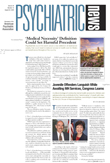The number of American adults who abused or were dependent on alcohol rose from about 13.8 million to 17.6 million over the past decade, according to new data from the National Institute on Alcohol Abuse and Alcoholism (NIAAA).
The results of the 2001-02 National Epidemiologic Survey on Alcohol and Related Conditions (NESARC) appeared in the June Drug and Alcohol Dependence.
Researchers were able to assess trends in alcohol use disorders over the 1990s by comparing data from the NESARC with those of a similar survey conducted a decade earlier, the 1991-92 National Longitudinal Alcohol Epidemiologic Survey (NLAES).
The NIAAA research team was led by Bridget Grant, Ph.D., chief of the Laboratory of Epidemiology and Biometry in NIAAA's Division of Intramural Clinical and Biological Research. The team found that while rates of alcohol abuse among the general population increased from 3.03 percent to 4.65 percent between 1991 and 2001, rates of alcohol dependence dropped from 4.38 percent to 3.81 percent during that same period.
As part of the NESARC study, staff of the U.S. Census Bureau conducted face-to-face interviews with a randomized, nationally representative sample of 43,093 respondents in 2001 and 2002.
The NLAES was also conducted by the U.S. Census Bureau using a randomized, nationally representative sample of 42,862 respondents in 1991 and 1992.
In both surveys, researchers used DSM diagnostic criteria to assess whether respondents were dependent on or had abused alcohol during the previous year. Some of their findings are reported below:
Alcohol Abuse
•
About 4.65 percent of American adults, or an estimated 9.7 million people, abused alcohol in 2001-02.
•
In 1991-92, 3.03 percent of Americans abused alcohol.
•
Rates of alcohol abuse among males (6.93 percent) were much higher than among females (2.55 percent) in 2001-02.
•
Prevalence rates of alcohol abuse were significantly greater among whites (5.1 percent) than Hispanics (3.97 percent) and African Americans (3.29 percent) in 2001-02.
•
While rates of alcohol abuse over the decade remained steady at about 10 percent for white males aged 18 to 29, alcohol abuse rates rose for African-American males (3.83 percent to 6.92 percent) and Hispanic males (5.85 percent to 9.08 percent) in that same age group.
Alcohol Dependence
•
The prevalence of alcohol dependence among American adults was 3.81 percent in 2001-02, representing 7.9 million people. A little more than twice as many men as women were dependent on alcohol.
•
In the early 1990s, 4.38 percent of American adults were dependent on alcohol.
•
Rates of alcohol dependence over the decade dropped slightly among whites (from 4.35 percent in 1991-92 to 3.83 percent in 2001-02) and Native Americans (9.01 percent to 6.35 percent).
“The NESARC report reinforces the need for ongoing research to define genetic and environmental factors that contribute to alcohol abuse and dependence, as well as current NIAAA initiatives for the early identification of at-risk drinkers and the application of the research-based interventions in vulnerable populations, especially underage drinkers,” NIAAA Director Ting-Kai Li, M.D., said in a press release.
An abstract of the article, “The 12-Month Prevalence Rates and Trends inDSM-IVAlcohol Abuse and Dependence: United States, 1991-1992 and 2001-2002,” is posted online at<www.sciencedirect.com>.▪
